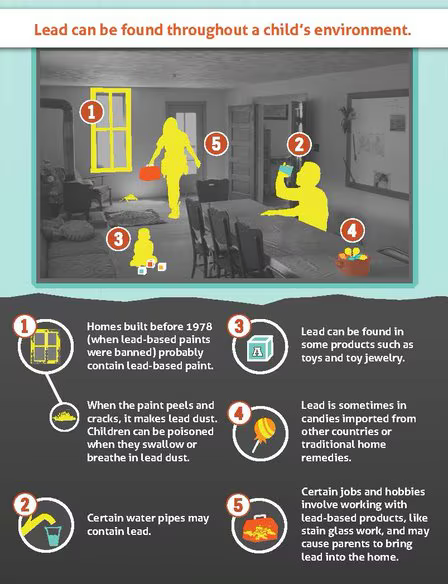Lead Control Program
Lead as a Heavy Metal
Lead is a naturally occurring heavy metal with the symbol Pb (from the Latin *plumbum*) and atomic number 82. It is dense, malleable, and has been widely used throughout history in various industries. Despite its utility, lead is highly toxic and poses significant health risks to humans and animals.

Common Sources of Lead
1. Lead-based paints (used before 1978 in homes).
2. Water systems with lead pipes or solder.
3. Contaminated soil from industrial activities or deteriorating paint.
4. Consumer products like toys, cosmetics, and jewelry.
5. Traditional remedies or imported goods.
6. Occupational exposure in industries such as construction, battery manufacturing, and smelting.
7. Airports, where children living nearby may be exposed to lead in the air and soil from aviation fuel used in piston-engine aircraft
Dangers of Lead Exposure
1. Neurological Effects:
- Damages the brain and nervous system.
- Causes developmental delays and learning difficulties in children.
- Contributes to memory loss and mood disorders in adults.
2. Hematological Effects:
- Interferes with hemoglobin production, leading to anemia.
3. Cardiovascular Impact:
- Increases blood pressure.
- Associated with cardiovascular diseases.
4. Kidney Damage:
- Prolonged exposure can impair kidney function.
5. Reproductive Issues:
- Reduces fertility in both men and women.
- Increases the risk of miscarriage or premature birth.
6. Children Are Most Vulnerable:
- Even small amounts of lead can significantly impact a child's physical and mental development.
How Lead Enters the Body
- Inhalation: Breathing in lead dust or fumes.
- Ingestion: Swallowing lead particles from contaminated food, water, or objects.
- Absorption: Through the skin, though less common.
Preventing Lead Exposure
- Test homes for lead-based paint and dust.
- Ensure water systems are free from lead contamination.
- Practice good hygiene, especially washing hands before eating.
- Avoid using products known to contain lead.
- Follow safety measures in workplaces involving lead.
Lead exposure remains a critical public health issue due to its severe and often irreversible effects, particularly on children.
